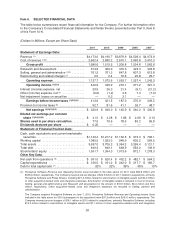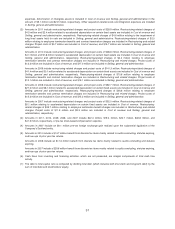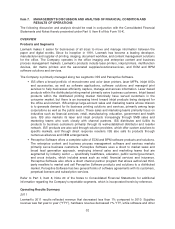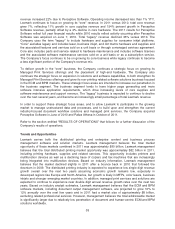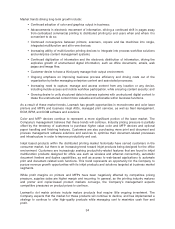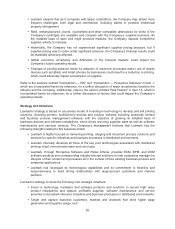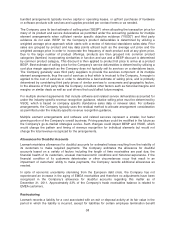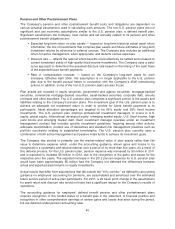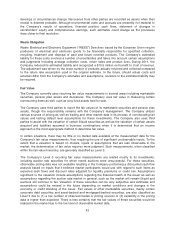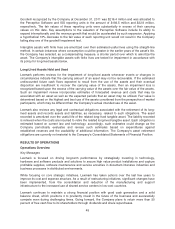Lexmark 2011 Annual Report Download - page 44
Download and view the complete annual report
Please find page 44 of the 2011 Lexmark annual report below. You can navigate through the pages in the report by either clicking on the pages listed below, or by using the keyword search tool below to find specific information within the annual report.Pension and Other Postretirement Plans
The Company’s pension and other postretirement benefit costs and obligations are dependent on
various actuarial assumptions used in calculating such amounts. The non-U.S. pension plans are not
significant and use economic assumptions similar to the U.S. pension plan, a defined benefit plan.
Significant assumptions the Company must review and set annually related to its pension and other
postretirement benefit obligations are:
• Expected long-term return on plan assets — based on long-term historical actual asset return
information, the mix of investments that comprise plan assets and future estimates of long-term
investment returns by reference to external sources. The Company also includes an additional
return for active management, when appropriate, and deducts various expenses.
• Discount rate — reflects the rates at which benefits could effectively be settled and is based on
current investment yields of high-quality fixed-income investments. The Company uses a yield-
curve approach to determine the assumed discount rate based on the timing of the cash flows
of the expected future benefit payments.
• Rate of compensation increase — based on the Company’s long-term plans for such
increases. Effective April 2006, this assumption is no longer applicable to the U.S. pension
plan due to the benefit accrual freeze in connection with the Company’s 2006 restructuring
actions. In addition, some of the non-U.S. pension plans are also frozen.
Plan assets are invested in equity securities, government and agency securities, mortgage-backed
securities, commercial mortgage-backed securities, asset-backed securities, corporate debt, annuity
contracts and other securities. The U.S. pension plan comprises a significant portion of the assets and
liabilities relating to the Company’s pension plans. The investment goal of the U.S. pension plan is to
achieve an adequate net investment return in order to provide for future benefit payments to its
participants. Asset allocation percentages are targeted to be 65% equity and 35% fixed income
investments. The U.S. pension plan employs professional investment managers to invest in U.S.
equity, global equity, international developed equity, emerging market equity, U.S. fixed income, high
yield bonds and emerging market debt. Each investment manager operates under an investment
management contract that includes specific investment guidelines, requiring among other actions,
adequate diversification, prudent use of derivatives and standard risk management practices such as
portfolio constraints relating to established benchmarks. The U.S. pension plan currently uses a
combination of both active management and passive index funds to achieve its investment goals.
The Company has elected to primarily use the market-related value of plan assets rather than fair
value to determine expense which, under the accounting guidance, allows gains and losses to be
recognized in a systematic and rational manner over a period of no more than five years. As a result of
this deferral process, for the U.S. pension plan, pension expense was increased by $3 million in 2011
and is expected to increase $5 million in 2012, due to the recognition of the gains and losses for the
respective prior five years. The expected increase in the 2012 pension expense for U.S. pension plan
would have been approximately $5 million had the Company not deferred the differences between
actual and expected asset returns on equity investments.
Actual results that differ from assumptions that fall outside the “10% corridor,” as defined by accounting
guidance on employers’ accounting for pensions, are accumulated and amortized over the estimated
future service period of active plan participants. For 2011, a 25 basis point change in the assumptions
for asset return and discount rate would not have had a significant impact on the Company’s results of
operations.
The accounting guidance for employers’ defined benefit pension and other postretirement plans
requires recognition of the funded status of a benefit plan in the statement of financial position and
recognition in other comprehensive earnings of certain gains and losses that arise during the period,
but are deferred under pension accounting rules.
40


